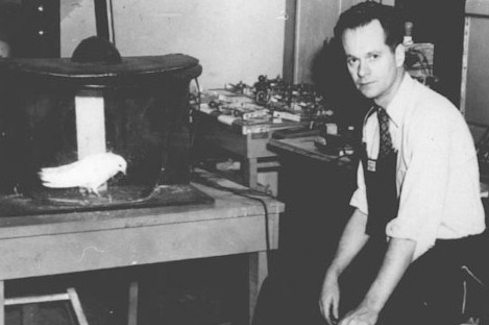“The real problem is not whether machines think but whether men do.”
– Burrhus Frederic Skinner
As per Wikipedia.com, “Skinner invented the operant conditioning chamber, also known as the Skinner Box. He was a firm believer of the idea that human free will was actually an illusion and any human action was the result of the consequences of that same action. If the consequences were bad, there was a high chance that the action would not be repeated; however if the consequences were good, the actions that lead to it would be reinforced. He called this the principle of reinforcement.”
When skeptics argued that superstitious behavior was unique to humans and couldn’t be explained by reinforcement, “B.F.” designed an experiment to address the critics’ objections. Instead of modifying the behavior of rats by delivering a food pellet each time they hit a lever, he used pigeons to demonstrate how susceptible birdbrains are to superstitious behaviors.
From ‘SUPERSTITION’ IN THE PIGEON First published in Journal of Experimental Psychology in 1947.
If a clock is now arranged to present the food hopper at regular intervals with no reference whatsoever to the bird’s behavior, operant conditioning usually takes place. In six out of eight cases the resulting responses were so clearly defined that two observers could agree perfectly in counting instances. One bird was conditioned to turn counter-clockwise about the cage, making two or three turns between reinforcements. Another repeatedly thrust its head into one of the upper corners of the cage. A third developed a ‘tossing’ response, as if placing its head beneath an invisible bar and lifting it repeatedly. Two birds developed a pendulum motion of the head and body, in which the head was extended forward and swung from right to left with a sharp movement followed by a somewhat slower return. The body generally followed the movement and a few steps might be taken when it was extensive. Another bird was conditioned to make incomplete pecking or brushing movements directed toward but not touching the floor. None of these responses appeared in any noticeable strength during adaptation to the cage or until the food hopper was periodically presented. In the remaining two cases, conditioned responses were not clearly marked.
Without sophisticated brain scanning equipment, Skinner couldn’t know dopamine was responsible for what he called “operant conditioning” AND for usurping the free will required to understand what he meant by “the idea that human free will was actually an illusion,”
More than a half century later, Dr. Robert Sapolsky, professor of biology and neurology at Stanford University, explained the chemistry behind operant conditioning and how dopamine-inducing expectations are involved in the superstitious behaviors exhibited by pigeons and human beings.





Discussion
Comments are closed.